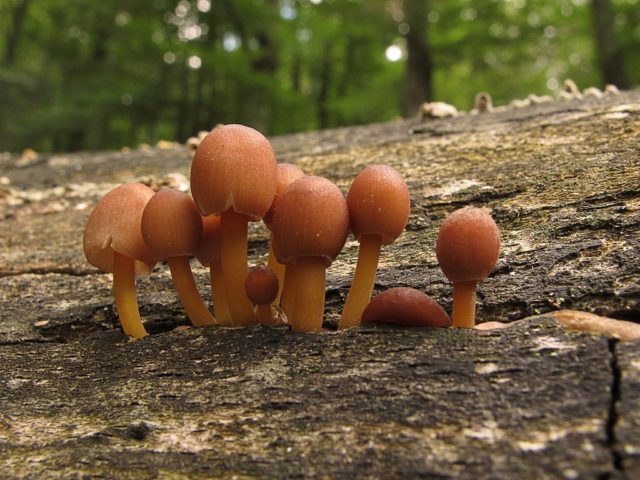Content
Mycena renati (Mycena renati) is a small lamellar fruit body from the Micenov family and the Mitsen genus. It was first classified by the French mycologist Lucienne Kele in 1886. Other names:
- mycene yellow-footed or yellowish;
- the cap is beautiful;
- helmet yellow-footed nitrate.

Young mushrooms on the trunk of a fallen tree
What Rene's micenes look like
Rene's mycena, which has just appeared, looks like a miniature bolt with a rounded ovoid head. In this case, the leg is noticeably longer than the apex. With age, the cap straightens, becoming first conical, resembling a bell in its shape, then - open, umbrella-shaped. In old mushrooms, the caps are straight or slightly concave, with a noticeable rounded tubercle at the junction with the stem. In such specimens, the lighter fringe of the hymenophore is clearly visible. The diameter varies from 0.4 to 3.8 cm.
The color is uneven, the edges are noticeably lighter than the middle of the cap. The mushroom can be buffy yellow, deep orange, pale pink, creamy beige, reddish brown or brownish yellow. The surface is dry, matte, smooth. The edge is finely toothed, slightly fringed, sometimes there are radial cracks. The pulp is transparent-thin, the scars of the plates shine through it. Brittle, white, has a characteristic unpleasant odor of urea or bleach. The overgrown Rene mycena has a pulp with a rich nitrogenous-rare smell, its taste is sweetish-neutral.
Hymenophore plates are straight, wide, sparse. Incremental and slightly descending along the stem. Pure white in young mushrooms, in adulthood darkens to a creamy yellow or pale pinkish hue. Sometimes red or orange stripes appear along the edge. The spore powder is white or slightly creamy; the spores themselves are glassy-colorless.
The leg is long, thin, flat or curved in a wave-like manner. Tubular, hollow inside. The surface is smooth, dry, yellow, sandy or light ocher, olive shade, with pubescence at the root. It grows from 0.8 to 9 cm in length and 1 to 3 mm in diameter.

The lower part of the legs is covered with long white fluff
Where Rene's mycenes grow
This smart, festively dressed mushroom is found in broadleaf and mixed forests in the southern regions of the Northern Hemisphere. It is widely distributed in Yugoslavia, Austria, France, Turkey, Asia and the Far East, in the south of Russia, in the Krasnodar Territory and Stavropol Territory, in North America. Mycenae Rene grows in large, tightly knit colonies on deadwood, rotting tree trunks, stumps and large fallen branches. Prefers calcareous soils and deciduous wood - beech, poplar, oak, willow, birch, alder, hazel, aspen. Loves shaded wet places, lowlands, ravines and banks of rivers and swamps. The period of active growth is from early summer to late autumn.

Elegant yellow-footed "bells" are noticeable against the background of brown-green bark from afar
Can Rene's micenes be eaten?
Mycena Rene is classified as an inedible species due to its low nutritional value and an unpleasant chlorine or nitrogenous pulp odor. There is no exact information on its toxicity.
Conclusion
Mycena Rene is a very bright little mushroom, inedible. Belongs to saprophytes growing on the remains of trees and converting them into fertile humus. Found in deciduous forests on fallen trees, in dead wood, on old stumps. Loves wet places. The mycelium bears fruit from May to November. Grows in large colonies, often covering the substrate with a solid carpet. It is included in the lists of endangered species in a number of European countries.








